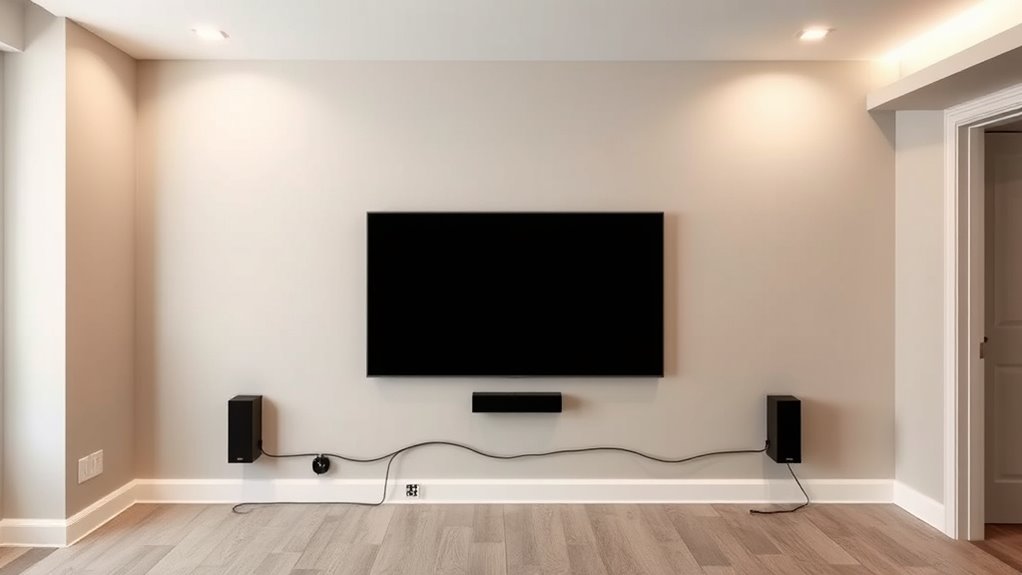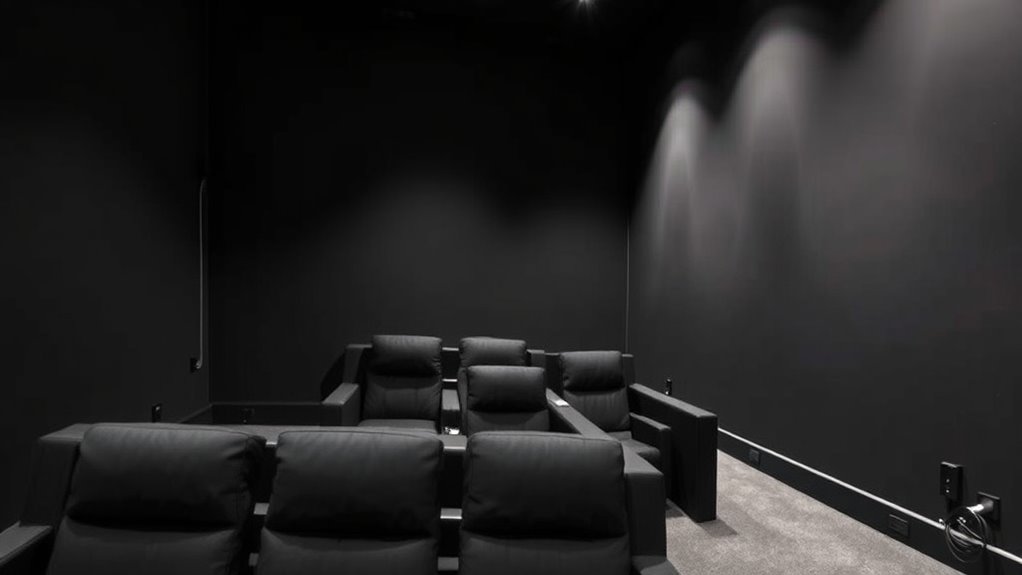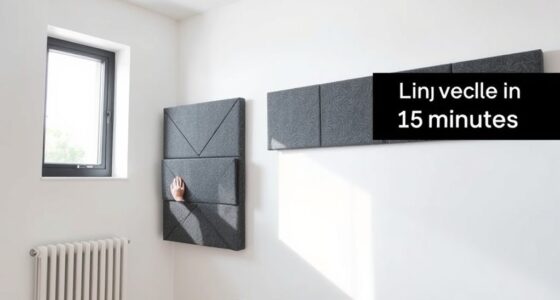To hide wires and cables in your theater room, consider installing in-wall wiring for a seamless, clutter-free look. Raceway systems offer an easy-to-install and paintable option to conceal cords along walls, keeping your space tidy and safe. Wireless technology can further reduce cable clutter and allow flexible speaker placement. Combining these solutions creates a sleek, professional setup. Keep exploring to discover how to implement these strategies effectively and achieve a truly clean theater environment.
Key Takeaways
- Use in-wall wiring to conceal cables, creating a seamless and minimalist look for your theater room.
- Install raceway systems along walls to hide and organize cables neatly and easily.
- Combine wireless audio technology to reduce cable clutter and improve room aesthetics.
- Ensure proper planning and adherence to electrical codes when running in-wall wires for safety.
- Regularly maintain and inspect concealed wiring solutions to ensure safety and optimal performance.

Hiding wires and cables can dramatically improve the look of your space by reducing clutter and creating a clean, streamlined appearance. If you’re setting up a home theater, you want your equipment to look sleek and professional, not like a tangled mess of cords. This is where effective cable management becomes essential. With the right techniques, you can conceal wires, making your room more inviting and less chaotic. One of the most popular options today involves in-wall wiring, which offers a seamless, almost invisible solution. By installing cables inside the walls, you eliminate the need for visible cords running across floors or along walls, creating a tidy environment that looks as good as it sounds. In-wall solutions are especially beneficial if you want to keep a modern, minimalist aesthetic, and they’re perfect for connecting large screens, speakers, and other AV components without sacrificing style.
Hiding wires with in-wall solutions creates a sleek, clutter-free home theater environment.
Wireless audio technology also plays a significant role in reducing cable clutter. When you switch to wireless speakers and sound systems, you eliminate a substantial number of cables typically associated with traditional setups. This not only simplifies your wiring but also grants you more flexibility in arranging your room. Wireless audio allows you to place speakers anywhere in your theater without worrying about running long cables through walls or under carpets. Combined with in-wall wiring for other components, this creates a streamlined, clutter-free environment that enhances the overall viewing experience. Proper cable management also involves understanding electrical safety considerations to prevent hazards and ensure reliable operation.
If in-wall wiring isn’t an option, raceway systems provide a practical alternative. These are plastic or metal channels that attach to the surface of your walls, hiding cables neatly inside. Raceways are easy to install and can be painted to match your wall color, making them less noticeable. They’re ideal for running cables along baseboards or behind furniture, keeping cords out of sight while maintaining easy access for future upgrades or adjustments. They also work well for managing power cords, HDMI cables, or speaker wires, helping you avoid tripping hazards and unsightly tangles.
Ultimately, whether you choose in-wall wiring, raceways, or wireless audio, the goal is to create a clean, organized space that enhances your viewing experience. Proper cable management isn’t just about aesthetics—it also improves safety and makes future upgrades simpler. By investing in these solutions, you turn your home theater from a cable nightmare into a sleek, professional-looking setup that’s as inviting as it is functional.
Frequently Asked Questions
Are In-Wall Wiring Installations Legal in All Areas?
In-wall wiring installations are generally legal if you follow local building codes and obtain homeowner permits where required. You should check with your local authorities before starting, as regulations vary by area. Properly adhering to codes guarantees safety and compliance, preventing potential issues during inspections or future sales. Always consult professionals or your local building department to confirm your specific area’s requirements before proceeding with in-wall wiring projects.
How Do I Prevent Cable Damage Over Time?
To prevent cable damage over time, you should focus on protecting the cable insulation and reducing wear and tear. Use high-quality cables with durable insulation, and avoid sharp bends or pinching. Installing cables in protected raceways or conduits adds an extra layer of defense against physical damage. Regularly inspecting your cables and replacing any that show signs of wear will also help maintain performance and longevity.
What Tools Are Needed for In-Wall Wiring?
To do in-wall wiring, you’ll need a wire gauge suitable for your cables, typically 14 or 16 for audio and video. You should also have cable connectors to secure connections and prevent damage. A drywall saw helps create holes, and a fish tape guides wires through walls. Additionally, a voltage tester ensures safety before working, and a drill can help with mounting. These tools make the process efficient and safe.
Can I Install Raceways Without Professional Help?
You can definitely install raceways without professional help if you’re comfortable with DIY projects. Did you know that over 60% of homeowners attempt their own cable management? Just remember, safety precautions are essential—turn off power, use proper tools, and follow instructions carefully. With patience and attention to detail, your DIY installation can look professional and keep your theater room neat and safe.
How Do I Maintain Access to Cables for Future Upgrades?
To keep future upgrades easy, you should incorporate access panels into your cable management plan. Install panels at key points so you can quickly reach and modify cables without dismantling your setup. Make sure the panels are easy to open and close, and label your cables clearly for quick identification. This way, you maintain easy access and keep your theater room neat and functional for any future upgrades.
Conclusion
By choosing in-wall or raceway solutions, you’ll transform your theater room from a tangled jungle into a sleek oasis. Think of it as giving your space a much-needed burst of fresh air, where every wire finds its place and your setup shines. With these simple tricks, you’ll enjoy a clutter-free environment that’s as impressive as the movies you watch—making your home theater a true masterpiece, free from the chaos of exposed cables.









